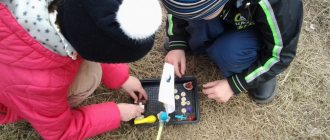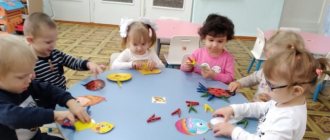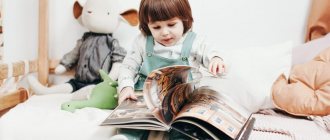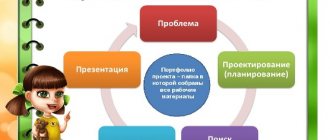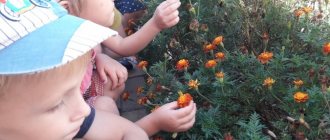How independence is formed and manifested in activities
Independent activity of children is a kind of autonomy. It is understood that the preschooler performs certain actions or solves practical problems without the participation of an adult.
From a theoretical point of view, independent activity requires setting a goal, choosing the means to achieve it, direct implementation, as well as at least minimal control.
Everything looks like a complex algorithm. But in practice it turns into a sequence accessible to the child. For example, looking at cubes or large parts of a construction set, the baby begins to build a tower, similar to the one he built yesterday with his dad. All components of the activity process are present here, but the preschool child himself conceives and implements the idea.
The manifestation of independence does not happen suddenly and instantly. At about 3 years old, the child begins to assert his independence at the everyday level. At first he performs the actions with the help of an adult, but the next step quickly comes when the baby wants to free himself from this help. Every now and then the persistent “I myself!” sounds.
The adult gives the child a model of how to perform the action. Imitation is a child’s primary activity. The preschooler takes independent actions on his own initiative, and he still needs to mature for them.
We can distinguish the stages of development of independent actions, which can be traced in any type of activity that the baby undertakes:
- Joint-shared attempts. They start an activity (drawing, storytelling, any practical activity) together. Then the adult actively helps the child, or even does the main part.
- Performed by a preschooler, but with hints and based on the demonstration of the necessary actions by the mentor.
- The adult proposes, that is, sets a task, and the child copes with it. This stage can be called performing.
- The preschooler himself takes the initiative and performs actions in order to achieve the goal that he sets for himself.
In childhood, the boundaries within which children try their hand are expanding every day. The preschooler begins to show independence in any activity available to him: cognitive, playful, creative, productive.
CHILDHOOD GUIDE
Organization of children's independent activities
in the conditions of a preschool educational institution, taking into account the Federal State Educational Standards for preschool education
Savchenko Lyubov Alexandrovna,
senior teacher of MBDOU d/s "Joy",
Tsimlyansk
In the Federal State Educational Standard for Education, the independent activities of children are highlighted less clearly than the joint activities of adults and children. However, in the target guidelines, independence, the ability to choose one’s occupation, is paramount. The need for the formation and development of independence is dictated by the needs of society for non-standard people who can think creatively and make discoveries for the benefit of humanity. And the solution to this issue is reflected in the process of developing independence, which allows a person to pose new problems and find new solutions.
In the scientific pedagogical literature there are different points of view on the definition of the concept of “independence” :
- This is the ability not to be influenced by various factors, to act on the basis of one’s views and beliefs.
- This is a general characteristic of a person’s regulation (management) of their activities, relationships and behavior.
- This is a gradually developing quality, a high degree of which is characterized by the desire to solve problems of activity without help from other people, the ability to set a goal for an activity, carry out basic planning, implement what was planned and get a result adequate to the goal, as well as contribute to the manifestation of initiative and creativity in solving emerging problems.
Scientific research indicates that under conditions of optimal upbringing and training , children can achieve a certain level of development of independence in various types of activities: gaming, communicative, motor, cognitive-research, productive (drawing, modeling, artistic work), labor, musical and artistic work. , reading.
The development of independence is facilitated by children mastering the ability to set a goal (or accept it from a teacher), think about the path to achieving it, implement their plan , and evaluate the result from the position of the goal.
The development of independence is an important indicator of a child’s readiness for school, especially emotional and volitional. The child develops the ability to act arbitrarily, regulating and subordinating his behavior to achieve a certain goal, which is set for him by an adult, a group of children, and then himself. By the end of preschool age, a 6-7 year old child sets a goal for himself, takes certain sequential actions to achieve it, and brings the job he has started to completion.
Thus, the independent activity of a preschooler is work that is performed without the direct participation of the teacher, according to his instructions, at a time specially provided for this, while the child consciously strives to achieve the goal, using his efforts and expressing in one form or another the result of mental or physical actions.
So: independent activity of children is one of the main models for organizing the educational process of preschool children:
1) free activity of pupils in the conditions of a subject-specific developmental educational environment created by teachers, ensuring that each child chooses an activity based on his interests and allows him to interact with peers or act individually;
2) activities of pupils organized by the teacher, aimed at solving problems related to the interests of other people (the emotional well-being of other people, helping others in everyday life, etc.).
Independence does not mean complete freedom of action and behavior; it is always within the framework of accepted norms in society, that is, there must be a rule for every need. We, adults, live by rules; there are also certain rules for children (in kindergarten there are some, in school - others). What rules exist in your groups? (what you took, put it back; do not shout or run around in the group; do not disturb others; fold clothes neatly in the locker, greet everyone who comes to the group, etc.).
The Federal State Educational Standard for Educational Education implies the creation of conditions for children to freely choose activities; in this sense, it is difficult to overestimate the importance of the subject-development environment. Let us remember what a developing subject-spatial environment is? The developing subject-spatial environment is a set of conditions that have a direct and indirect impact on the comprehensive development of a child in kindergarten, on the state of his physical and mental health, on the success of his further education, as well as on the activities of all participants in the educational process in a preschool institution. According to the requirements of the Federal State Educational Standard for Educational Education, the developing subject-spatial environment must be content-rich, transformable, multifunctional, variable, accessible and safe.
The scheme for the development of any type of activity in accordance with the concept of L.S. Vygodsky is as follows: first it is carried out in joint activities with adults, then in joint activities with peers and, finally, it becomes an independent activity of the child. In this case, a special role is assigned to the teacher. The teacher must create a diverse gaming environment (we are talking about a developing subject-spatial environment in a preschool educational institution), which must provide the child with cognitive activity, must correspond to his interests and be developmental in nature. The environment should provide children with the opportunity to act individually or together with peers, without imposing mandatory joint activities. The teacher can get involved in children’s activities in cases of conflict situations that require adult intervention, or, if necessary, help a particular child join a peer group.
The subject-development environment should be organized in such a way that every child has the opportunity to do what he loves. Such an environment must meet the individual and age characteristics of children and their leading activity – play. At the same time, it should contribute to the development of creative abilities, awaken imagination, activity, teach communication, and vivid expression of one’s feelings.
Play in kindergarten should be organized , firstly, as a joint game between the teacher and the children, where the adult acts as a playing partner and at the same time as a carrier of the specific “language” of the game. The natural emotional behavior of the teacher, who accepts any children’s plans, guarantees freedom and ease, the child’s enjoyment of the game, and contributes to the desire in children to master the methods of play themselves. Secondly, at all age stages, play should be preserved as a free independent activity of children, where they use all the play tools available to them, freely unite and interact with each other, where the world of childhood is ensured to a certain extent, independent of adults.
Along with play, free productive activity of children (constructive, visual, etc.) occupies a significant place in a child’s life. Just like in play, the child’s development opportunities are enriched here.
In order to organize independent artistic activity, a child must have developed artistic experience, which the child acquires in classes. Systematic training allows you to gradually accumulate and increase the volume of skills and abilities, and already on your own initiative, children can express themselves in various types of artistic activities: musical, artistic and speech, visual, theatrical and gaming.
Mathematics for a preschooler should be fun and entertaining. For independent cognitive mathematical activity to be effective, it is necessary:
— create a special subject-development environment;
- offer children a complex of entertaining gaming mathematical material in independent cognitive and play activities;
- use special techniques for guiding independent cognitive and gaming mathematical activities.
The effectiveness of independent cognitive mathematical activity can be tracked by the level of children's independence; cognitive activity of children; level of motivation.
Thus, the teacher must devote a large amount of time to organizing the independent activities of children in a preschool educational institution during the day, at a time specially provided for this, where the child consciously strives to achieve the goal, using his efforts and expressing in one form or another the result of mental or physical actions. And if in joint activities with children the teacher is an equal partner, then in independent activities the teacher is only an observer.
List of used literature:
- Raising preschoolers to be independent: Collection of articles - Russian state. Ped. Hertzin University, St. Petersburg: Detstvo-PRESS 2000, 192 p.
- Kononova I., Ezhkova N. Preparing children for independent activities. // Preschool education, 1991 - No. 6. - P. 11-14
- Kuznetsova N.P., Creating a developmental environment step by step // Directory of senior educator No. 8 2016.
- Educational environment and organization of independent activities of senior preschool age [Text]: methodological recommendations / ed. O.V. Dybina/-M.: Center for Pedagogical Education, 2008.
- Federal State Educational Standard DO.
Implementation of independent musical activity of preschoolers Interaction between kindergarten and family in the context of the implementation of the Federal State Educational Standard for Preschool Fiction Fiction as a means of speech development of preschoolers in the context of the implementation of the Federal State Educational Standard for Preschool Education Development of young children in various types of activities in accordance with the Federal State Educational Standard for Preschool Education >
Preschooler's independence in play
Play is the most natural activity in preschool age and the leading activity in a child’s development. In play settings, children discover themselves and social relationships. A role-playing game is an ideal environment for developing independence.
The adult is present in the child’s play activities, but indirectly, through a role. That is, children see the behavior and attitudes of the adults around them, take them as a model, and then model them in their games.
The play of younger preschoolers is mainly imitation. They try to copy gestures and tonality of statements. They scold “offending” dolls, just like a mother. They show concern, playing the role of a doctor, etc. However, the choice of plot, the selection of substitute objects (what will be a thermometer, and what will be a plate of porridge) occurs independently.
Thanks to the effective embodiment of the role, children acquire work skills in the game. If according to the plot you need to clean the room, then the baby takes on putting away scattered things or sweeping.
With the development of play activity, children show more and more independence. They complicate plots, distribute roles, agree on rules, and themselves control their implementation.
Tasks of organizing independent activities in the senior group
The independent activity of children in the preparatory group is characterized by the ability to solve many problems that will be especially useful in preparing for school.
The most effective of them are:
- Development of strong-willed and motivational qualities . In this case, the child develops psychological stability, which allows him to be protected from various factors from the external environment: someone else’s opinion, extraneous noise or voices, criticism addressed to him. All this allows you to develop a skill in which the child will bring his activities to their logical conclusion. In older groups, this task allows you to create the necessary conditions for the formation of the skill of self-analysis, as well as value judgments for certain actions.
- Development of self-regulating processes. The preschooler learns to accurately calculate the percentage of energy spent on performing certain actions, and also understands the need to change activities or have rest. From the age of 5-6 years, the child begins to develop important physiological processes in the nervous system, which develops perseverance, concentration, as well as a positive reaction to constructive criticism and comments.
- Formation of an important ability to independently construct an algorithm of actions. In this case, the child learns to build a detailed plan for research, play, work or observation activities without outside help. The importance of having friendships with both children and adults also develops.
- Development of social and cultural qualities through various games, which are based on a plot-role interaction technique. A good example is the game activity “Hospital”, “Shop”, “Bank”, which makes it possible to learn more deeply about certain features of different activities.
- Strengthening independent skills . In this case, the child learns various actions that are aimed at undressing and dressing, maintaining etiquette, personal hygiene or cleanliness of the kindergarten. Such things should be done automatically, without the participation of educators. There is also the development of independence through the implementation of various instructions from the teacher. Such education improves conscientious behavior towards preschool employees on duty.
Based on the tasks described above, the preschooler develops play, artistic and speech, cognitive, as well as social and communicative activity.
In addition, the teacher can help improve work activity, so that the child will strive to help elders in everything - from cleaning the kindergarten territory to caring for flowers.
Washing doll clothes is an example of developing labor skills when organizing independent activities for children in a preparatory group
The independent activity of children in the preparatory group is a particularly important personality trait, which is characterized by an increased desire to quickly and effectively solve certain problems, without outside help from an adult.
This personal trait allows one to increase criticality, initiative, and also develop the most adequate self-esteem in a child.
Independent creative activity
Independence in creative activity develops gradually both in simple exercises and when the child becomes involved in artistic activities. At first, careful intervention from an adult is necessary to help with specific operations.
The youngest preschooler is just beginning to master the tools necessary for creativity. Holds a pencil confidently, but draws mostly chaotic lines. Already making some constructions, but only the simplest ones.
The field for the manifestation of creative independence in early preschool age is still gaining diversity. It is presented:
- Drawing
- Making mosaic pictures
- Construction from large parts
At 3-4 years of age there is already interest in independent creative activities. It seems that the baby is engrossed in rolling the car while the mother is putting together a mosaic figure and unsuccessfully trying to get the child interested in this activity. And after some time, the baby himself, albeit chaotically, connects the elements of the mosaic or builds a bridge according to the model. Some children will agree to little help. Others will only accept the suggested name.
In middle preschool age, interest in the musical field intensifies. If earlier children pressed the keys of children's musical instruments and rejoiced at the sound they produced, then by the age of five they are interested in chords. Preschoolers pick up the melody by pressing 2-3 keys in a row and begin to experiment with sounds.
Five-year-old children discover word creation. This is an important stage of speech development - the grammatical structure of speech is formed. What words do children come up with! Moreover, they do this not at the behest of an adult. It's time to encourage your child to write his own stories. An adult can offer a preschooler a series of pictures and ask them to tell a story.
Independent creativity of older preschoolers
Older preschoolers do not need such support for their artistic or design experiments. They prefer to hear feedback only about the result. They plan, select funds, and also carry out their plans without outside help.
Of course, children eventually expect to hear praise. At the very least, support, but not criticism. If a child diligently created his drawing or appliqué, then he wants to receive a positive assessment, and not a remark that not everything was successful.
Negative assessments suppress the need for independent activity of this type. Drawings are not praised - the preschooler loses the desire to draw. If they don’t admire the craft, the child’s interest will fade as well.
The preschooler’s motivation for independent action will not disappear; it will manifest itself in other areas. However, it is important for adults to take into account that creativity should not be taken risks and that it is worth supporting the preschooler.
A fairly high level of speech development in older preschoolers opens up primary literary creativity for them. They make up their own stories and rhyme words. Such exercises are characterized by a high degree of independence. If an adult asks a 5-6 year old child to compose a fairy tale, he will most likely refuse. It’s another matter if this impulse comes from within, and the preschooler himself decided to come up with an amusing story.
The goals of writing can be different - to fantasize about what you want, to repeat a memorable plot with a focus on your life, to make your loved ones or friends laugh. In any case, such creativity perfectly develops speech and imagination, and also forms creative initiative.
Free INDEPENDENT ACTIVITY for preschoolers. consultation on the topic
Free INDEPENDENT ACTIVITY of preschoolers.
The Federal State Educational Standard for Preschool Education defines support for children's initiative in various types of children's activities as one of the principles of preschool education. If we analyze the requirements of the standard for the psychological and pedagogical conditions for the implementation of the basic educational program, we will see that supporting the child’s independence is one of the most important conditions.
In the scientific pedagogical literature there are different points of view on the definition of the concept of “independence”:
1. This is the ability not to be influenced by various factors, to act on the basis of one’s views and beliefs.
2. This is a general characteristic of a person’s regulation (management) of their activities, relationships and behavior.
3. This is a gradually developing quality, a high degree of which is characterized by the desire to solve problems of activity without help from other people.
Currently, independent activity is one of the components of the educational process in kindergarten.
Independent activity of children is considered as activity that is performed without the direct participation of the teacher, while the child consciously strives to achieve the goal. The teacher’s task is to make the child want to engage in one activity or another.
Moreover, the child should have the opportunity to satisfy his interests and needs in independent activity, and on the other hand, the teacher also organizes independent activity to solve the educational tasks of the program. And here, it is important to come up with a developing subject-spatial environment that will activate and arouse the child’s interest in activities. To find didactic materials that, on the one hand, would motivate children to engage in activities, and, on the other hand, would allow them to solve the problems of the educational process.
Independent activity of children is one of the main models for organizing the educational process of preschool children:
1) free activity of pupils in the conditions of a subject-specific developmental educational environment created by teachers, ensuring that each child chooses an activity based on his interests and allows him to interact with peers or act individually;
2) activities of pupils organized by the teacher, aimed at solving problems related to the interests of other people (the emotional well-being of other people, helping others in everyday life, etc.).
The scheme for the development of any type of activity in accordance with the concept of L. S. Vygodsky is as follows: first it is carried out in joint activities with adults, then in joint activities with peers and, finally, it becomes an independent activity of the child. In this case, a special role is assigned to the teacher.
To develop children's independence, the teacher must build the educational environment in such a way that children can:
- learn from your own experience, experiment with various objects, including plants;
- be present during the day, both in same-age and different-age groups;
- change or design the playing space in accordance with emerging gaming situations;
- be autonomous in their actions and decisions available to them.
The main types of children's activities in the preschool period are playful and productive.
There are two types of independent activities of children in kindergarten: 1.Game activity: director's play, role-playing game, games with rules. 2. Productive activities: design, fine arts, manual labor.
The main criterion for assessing the independent play activity of pupils should be play behavior, ways of spreading the game, the child’s ability, depending on his own plan, to include conditional actions with objects, role-playing dialogues, and combine various events into the game.
Play is one of the most valuable new developments of preschool age. While playing, the child freely and with pleasure masters the world in its entirety - in terms of meanings and norms, learning to understand the rules and creatively transform them.
It is the game that should be primarily used by teachers. L.S. Vygotsky defined play as the leading activity in preschool age. L.I. Bozovic considers it necessary that leading activities constitute the main content of the lives of children themselves. Thus, the game is a kind of center around which the main interests and experiences of children are concentrated. Theatrical activity is a type of game.
Theatrical activities in kindergarten can organizationally permeate all routine moments: be included in all classes, in the joint activities of children and adults in their free time, and carried out in children’s independent activities. Theatrical activities can be organically included in the work of various studios and clubs; products of theatrical activities (stage plays, dramatizations, performances, concerts, etc.) can be included in the content of holidays, entertainment and leisure.
Theatrical play in children's independent activities: independent children's games reflect characters and plots that excite children. Thus, children often play Snow Maiden and Father Frost, creating a new world of the New Year holiday in the playroom. Vivid stories, games, round dances, learned in joint free activities of children and adults, in games and activities, also contribute to the emergence of independent theatrical play for children.
Theatrical activities help make the life of children in the group more exciting and varied.
The development of free play activity requires support from an adult. At the same time, the role of the teacher in the game can be different depending on the age of the children, the level of development of gaming activity, the nature of the situation, etc. The teacher can act in the game both as an active participant and as an attentive observer.
In order to develop gaming activities, it is necessary:
• create conditions during the day for children to play freely;
• identify play situations in which children need indirect help;
• watch children playing and understand exactly what events of the day are reflected in the game;
• distinguish children with developed play activity from those whose play is poorly developed;
• indirectly lead the game if the game is of a stereotypical nature (for example, offer new ideas or ways to implement children's ideas);
• know the children's subculture: the most typical roles and games of children, understand their significance;
• establish relationships between play and other activities.
Productive activity in preschool education is the activity of children under the guidance of an adult, as a result of which a certain product appears.
It is this activity that contributes to the development of graphic skills in children of senior preschool age, fosters perseverance, creates pedagogical conditions for the process of socialization of senior preschoolers and, along with play, is of greatest importance for the development of the psyche during this period.
Engaging in productive activities develops the child’s creative imagination, promotes the development of hand muscles, coordination of movements, and develops thinking skills (analysis, synthesis, ability to compare).
When conducting classes, favorable conditions are created for the formation of such qualities as inquisitiveness, initiative, curiosity and independence.
Productive activity has an impact on the comprehensive education of a preschooler. It is closely related to sensory education. The formation of ideas about objects requires the assimilation of knowledge about their properties and qualities, shape, color, size, position in space.
Independent productive activity arises on the initiative of the child to satisfy his individual needs (make a gift for his mother, make a toy, etc.) The adult’s task is to develop independence without violating the child’s plan, using hints, drawing attention to the object, asking questions.
Signs of manifestation of independence are the child’s attention and interest in a certain activity and the ability to transfer what he has learned into his own new activity.
Independent activity has great potential for the development of a child’s personality:
- development of initiative, activity,
- consolidation of existing skills, methods of activity,
- bright impressions find a way out, tension decreases, the child’s inner world becomes comfortable,
- self-esteem, self-confidence and self-confidence rises.
Productive activities are largely related to story-based play and contain elements of practical experimentation with materials. Just as often, actions arise on the principle of what will happen if.... At the same time, in the arsenal of children of senior preschool age there are various types of productive activities: work on ready-made samples and graphic diagrams and work with unfinished products and verbal descriptions.
A developing subject-spatial environment in the group should facilitate creative movement in working with the selected material. Therefore, the teacher provides preschoolers with materials, samples of possible work, and ensures that the children have a supply of appropriate materials for everyone who wants to continue working.
You should always have waste and natural materials on hand, combining which at your own choice, the child can make various things - these are pieces of cardboard, foam plastic, cardboard boxes of different sizes, wire, pieces of fabric and rope, old felt-tip pen cases, pine cones, acorns, small dry twigs, etc., placed in different containers. Of all the variety of materials available in kindergarten for free design, the plastic LEGO construction set is the most popular among preschoolers.
It is necessary to have a set of large building materials in the group, although its parts are more often used not for construction as such, but in a story game to designate a conditional playing space. We also include a variety of mosaics - geometric and traditional - among materials that stimulate children's independent productive activity.
Mosaic is an excellent object for educational and research activities (experimentation). Working with it promotes the development of a child’s manual motor skills, analysis of the relationships between parts and the whole, and the formation of spatial concepts. They are necessarily provided to children for free activity.
Pictures—puzzles—puzzles consisting of many parts have become an integral attribute of a child’s life. Assembling such puzzles can also be considered a productive activity. Construction kits and a variety of puzzles, mosaics, etc. must be at the free disposal of children.
Preparing a child for school means teaching him to act actively, creatively, and consciously. This is largely facilitated by properly organized work in kindergarten to develop independent artistic activities: theatrical and playful, visual, artistic, speech and musical.
In independent musical activities, children, on their own initiative, sing, dance in circles, select light melodies on a metallophone, and perform simple dances. They can themselves organize games in “concerts”, “theater”, “performance” (with toys, with flat figures, dolls).
Among the games, the main place is occupied by “musical classes” and “concerts”, based on the experiences acquired by children, mainly in classes. Children compose chants and songs using familiar movements, come up with dances and formations.
Children often include musical and didactic games in their independent activities, which develop children’s ability to perceive and distinguish the basic properties of musical sound: “Musical Lotto”, “Guess who’s singing”, “Two Drums”, “Be quieter - louder on the tambourine” , “Name the song from the picture”, etc.
In independent activities, children often use children's musical instruments. Children show a desire for independent musical activity and, on their own initiative, apply their musical experience in a wide variety of types of musical practice.
Independent musical activity of preschoolers is proactive, creative, based on acquired experience, is distinguished by a variety of forms and is the initial manifestation of self-learning.
The main indicators of independent activity are interest in it on the part of the child and the manifestation of initiative and independence in setting tasks and choosing a way to implement plans.
The teacher should devote a large amount of time during the day to organizing the independent activities of children in preschool educational institutions. And if in joint activities with children the teacher is an equal partner, then in independent activities the teacher is only an observer.
Thanks to the transition to a new form of calendar planning, the organization of independent activities is clearly reflected and intersects (integrates) with other forms of work during the day (walking, routine moments, group - subgroup, joint activities).
Thus, the independent work of children in a preschool educational institution is work that is carried out without the direct participation of the teacher, on his instructions, in the time specially provided for this, while the child consciously strives to achieve the goal, using his efforts and expressing in one form or another the result of mental or physical actions.
Bibliography
1. Gubanova N.F. Play activities in kindergarten. – M.: Mozaika-Sintez, 2006
2. Dybina O.V. Educational environment and organization of independent activities of senior preschool age: methodological recommendations. — M.: Center for Pedagogical Education, 2008
3. Zvorygina E.V. I'm playing!: conditions for the development of children's first amateur story games: a manual for educators and parents. – M.: Education, 2007
4. Kononova I., Ezhkova N. Preparing children for independent activities. // Preschool education, 1991, No. 6.
5. Komarova T.S. Children's artistic creations. — M.: Mosaika-Sintez, 2005
